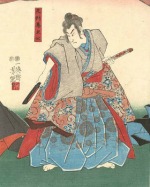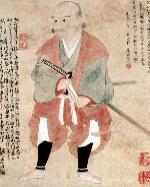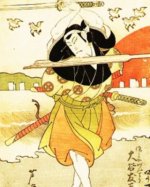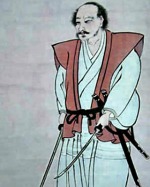The Japanese Samurai at War
Talk the Talk
From the 16th century, Japanese samurai armies went onto
the battlefield with three types of flags in order to help the generals distinguish which troops were fighting on which side. They were;
The Nobori – A long vertical flag that often depicted a family’s coat-of-arms
The Uma-jirushi – Literally meaning ‘horse insignia’, the Uma-jirushi was designed to identify the position of the general.
The size of this flag would depend on the size of his income.
The Sashimono – A personal banner worn on the backs of individual soldiers. It would often bare the coat-of-arms of the wearer though this was not always the case.
Walk the Walk
Traditionally, when a samurai went into battle he was there to gain honour for himself and his family name.
He did this by challenging individual warriors to a fight; once his opponent was despatched, he would move on to the next and the next until the battle was over or he himself was injured or killed.
However by the second half of the 16th century, major battles in Japan became more advanced and samurai war tactics were more complex, often involving larger numbers of troops.
The army’s victory was all important and now warriors were expected to fight how, when and where they were told by their general.
He did this by challenging individual warriors to a fight; once his opponent was despatched, he would move on to the next and the next until the battle was over or he himself was injured or killed.
However by the second half of the 16th century, major battles in Japan became more advanced and samurai war tactics were more complex, often involving larger numbers of troops.
The army’s victory was all important and now warriors were expected to fight how, when and where they were told by their general.
Samurai History Fact
For the majority of the history of the samurai,
battles were fought by professional soldiers whose only purpose in life was to serve their lord in both times of war and peace.
However, from the middle of the 15th century and the onset of the Onin War up to the latter half of the 16th century, many of the warriors involved in conflict were part-time soldiers who would return to their normal lives, often as farmers, after a battle took place.
However, from the middle of the 15th century and the onset of the Onin War up to the latter half of the 16th century, many of the warriors involved in conflict were part-time soldiers who would return to their normal lives, often as farmers, after a battle took place.
 As the ruling elite of Japan, war was the Japanese samurai’s business and over the centuries would mould them into who they were as a social class.
As the ruling elite of Japan, war was the Japanese samurai’s business and over the centuries would mould them into who they were as a social class. Samurai war tactics, strategies and customs would all change down the ages but a willingness to serve and even die for their lord was a constant, especially if the death of a samurai could be a glorious one in the heat of battle. By doing well on the battlefield, a warrior would gain honour for himself and his clan along with a sense of immortality through the samurai war stories that would be told about him by future generations.
More practically, the best warriors were also often given land as payment for serving in battles and in return would supply men during times of turbulence, with the number of men required depending on his yearly rice yield.
The Formalities of War
The early code of honour that the samurai strove to live by was known as kyuba no michi (the way of the bow and horse) or yumiya toru mi no narai (the practices of those who use the bow and arrow). As a part of this code, certain formalities were to be followed on the battlefield, the idea being that war could be conducted in a civilised, gentlemanly fashion.However, while this sounded good in stories, the realities of war were usually very different. The folly of attempting to fight in an idealised, sporting manner was demonstrated in no uncertain terms during the Battle of Kurikara, fought at the end of the Heian Period in 1183 during the Genpei War.
The ruling Taira Clan faced their enemies, led by Yoshinaka of the Minamoto Clan and agreed to fight a fair, formal battle despite heavily outnumbering their opponents. First, there was an archery duel followed by fighting between selected small bands of combatants. Next came a pitched battle with both armies being represented by a hundred warriors, but this is where the formal nature of the proceedings abruptly ended.
The Minamoto Clan attacked with their full force, driving their enemies into a narrow closed-off valley then stampeded a huge herd of oxen with pine torches attached to their horns. At the same time, ambush troops attacked from the sides of the valley firing round after round into the trapped Taira soldiers. According to the Heike Monogatari, a near-contemporary epic poem that details the events of the Genpei War;
As is often the case, future generations failed to learn the lessons of history and in the thirteenth century, battles would again often take on a certain formalness; first the commanders would declare their ancestry and then proclaim themselves great warriors. After shouting insults at their opponents, they released some arrows at each other and then charged while the lesser samurai waited their turn.
However, as much as samurai warriors may have liked to fight formally, war does not usually permit this. A conflict is a bloody, horrific business which, to state the obvious, yields high death rates. In most battles, there would have been little time for searching for and challenging worthy opponents so instead in many cases the nearest member of the opposition would have to do.
In one of the more gruesome aspects of the history of the samurai, when a victory was won the heads of high-ranking defeated enemies were removed. The women of the victorious court would then comb the hair, use cosmetics on the faces and mount them in order to make them look more presentable. They would then be presented to the warlord who would, after inspecting the severed heads, proceed to reward the warrior who took the first head and those who excelled in the battle by bestowing great honour upon them along with rewards of gold, land or titles.
Over time, this would prove to be a 'game changer' when it came to how warfare was conducted in the country as the army with the most and/or best-trained samurai warriors would no longer necessarily have the upper hand. Many believed the gun to be a dishonourable weapon because it evened the playing field and allowed the peasantry and lesser units such as the infantrymen (ashigaru) to be as effective as highly trained warriors.
However, those that refused to equip their armies with the new weapon tended to be beaten on the battlefield by those who would so most successful generals were soon advocates of the use of the firearm; soon after their arrival, they were being made at a faster rate and higher quality than anywhere else in the world.
Within thirty years, the potential of the firearm began to be fully realised and they were instrumental in Oda Nobunaga’s domination of Japan in the latter part of the sixteenth century. Nobunaga was probably the first Japanese commander to use the ‘roll, volley, fire’ technique which involves one line of soldiers shooting (often from behind a shield known as a tate) while a second row reloads so that there is a continuous series of shots fired at the enemy. This samurai war tactic (depicted below) and others that involved firearms were instrumental in beginning the process of the unification of the country, so much so that in 1571, warlord Shingen Takeda declared;
While his and the Tokugawa governments that followed during the Edo Period (1603 - 1868) ruled with an iron fist, Japan did see a period of around two hundred years of sustained peace, which was no mean feat for a country that had been built on the battles of a warrior elite. Without war there was less need for practicing martial disciplines so during the period, the overall fighting skills of the samurai warrior class fell into decline and samurai war stories became strictly an exercise in history and reminiscence of a bygone era.
There were however still some who dedicated themselves to practising bushido (the way of the warrior) and the best swordsmen in the country would often challenge each other to duels, many of which were to the death. Gunsmiths also existed in Japan throughout the Edo Period but they were few and far between and required special dispensation from the government in order to practice their craft.
Cook, H. 1993. Samurai – The Story of a Warrior Tradition. London. Blandford Press.
Henshall, K. 2004. Second Edition. A History of Japan – From Stone Age to Super Power. Hampshire. MacMillan Press
Latz, G. [Internet]. 2015. Samurai Groups and Farming Villages. Encyclopaedia Britannica. Available from: http://www.britannica.com/EBchecked/topic/300531/Japan/23147/Samurai-groups-and-farming-villages [Accessed August 27, 2015].
Seal, F.W. [Internet]. 2013. Oda Nobunaga. The Samurai Archives. Available from: http://www.samurai-archives.com/nobunaga.html#5 [Accessed August 27, 2015].
Totman, C. 2005. Second Edition. A History of Japan. Cornwall. Blackwell Publishing.
Turnbull, S. R. 1989. Samurai Warlords – The Book of the Daimyo. London. Blandford Press.
"Thus did some 70,000 horsemen of the Taira perish, buried in this one deep valley; the mountain streams ran with their blood and the mound of their corpses was like a small hill".
As is often the case, future generations failed to learn the lessons of history and in the thirteenth century, battles would again often take on a certain formalness; first the commanders would declare their ancestry and then proclaim themselves great warriors. After shouting insults at their opponents, they released some arrows at each other and then charged while the lesser samurai waited their turn.
However, as much as samurai warriors may have liked to fight formally, war does not usually permit this. A conflict is a bloody, horrific business which, to state the obvious, yields high death rates. In most battles, there would have been little time for searching for and challenging worthy opponents so instead in many cases the nearest member of the opposition would have to do.
The Ceremonies and Rituals of War
Before setting out to battle, a warrior in medieval Japan would partake in farewell rituals. Much of these rituals were preoccupied with praying to the gods of war, especially the most important of them, Hachiman, the deity of the Minamoto Clan and believed to be the spirit of Emperor Ojin. After a specially prepared meal, the lord would have an attendant attach his armour and weapons. Once he was ready, he would rally his men by shouting, “Glory, Glory”, to which his generals would reply, “Yes, Yes”. Next, he would receive a blessing from a priest then, surrounded by his three banners, he would lead his army off to their campaign.In one of the more gruesome aspects of the history of the samurai, when a victory was won the heads of high-ranking defeated enemies were removed. The women of the victorious court would then comb the hair, use cosmetics on the faces and mount them in order to make them look more presentable. They would then be presented to the warlord who would, after inspecting the severed heads, proceed to reward the warrior who took the first head and those who excelled in the battle by bestowing great honour upon them along with rewards of gold, land or titles.
The Arrival of the Gun
In around 1542, a Chinese boat was blown onto the island of Tanegashima carrying three Portuguese travellers who became the first Europeans to ever set foot on Japanese soil. Two of them were armed with guns which, perhaps unsurprisingly, caught the attention of the lord of the island who promptly bought them and ordered his smiths to make duplicates.Over time, this would prove to be a 'game changer' when it came to how warfare was conducted in the country as the army with the most and/or best-trained samurai warriors would no longer necessarily have the upper hand. Many believed the gun to be a dishonourable weapon because it evened the playing field and allowed the peasantry and lesser units such as the infantrymen (ashigaru) to be as effective as highly trained warriors.
However, those that refused to equip their armies with the new weapon tended to be beaten on the battlefield by those who would so most successful generals were soon advocates of the use of the firearm; soon after their arrival, they were being made at a faster rate and higher quality than anywhere else in the world.
Within thirty years, the potential of the firearm began to be fully realised and they were instrumental in Oda Nobunaga’s domination of Japan in the latter part of the sixteenth century. Nobunaga was probably the first Japanese commander to use the ‘roll, volley, fire’ technique which involves one line of soldiers shooting (often from behind a shield known as a tate) while a second row reloads so that there is a continuous series of shots fired at the enemy. This samurai war tactic (depicted below) and others that involved firearms were instrumental in beginning the process of the unification of the country, so much so that in 1571, warlord Shingen Takeda declared;
"Hereafter guns will be the most important weapon. Therefore, decrease the number of spears and have the most capable men carry guns. Furthermore, when you assemble your soldiers, test their marksmanship and order that the selection [of gunners] be in accordance with the results".
The Samurai in Peace
Ieyasu Tokugawa, one of Nobunaga’s generals who went on to be the Shogun, would complete the process of the unification of Japan in the early seventeenth century and soon after banned the use of guns. He closed the borders to foreigners and brought in new laws to control the populace and keep would-be warlords in check.While his and the Tokugawa governments that followed during the Edo Period (1603 - 1868) ruled with an iron fist, Japan did see a period of around two hundred years of sustained peace, which was no mean feat for a country that had been built on the battles of a warrior elite. Without war there was less need for practicing martial disciplines so during the period, the overall fighting skills of the samurai warrior class fell into decline and samurai war stories became strictly an exercise in history and reminiscence of a bygone era.
There were however still some who dedicated themselves to practising bushido (the way of the warrior) and the best swordsmen in the country would often challenge each other to duels, many of which were to the death. Gunsmiths also existed in Japan throughout the Edo Period but they were few and far between and required special dispensation from the government in order to practice their craft.
Written by Andrew Griffiths – Last updated 14/10/2023. If you like
what you see, consider following the History of Fighting on social media.
Further Reading:
Cohen, R. 2002. By the Sword. New York. The Modern Library.Cook, H. 1993. Samurai – The Story of a Warrior Tradition. London. Blandford Press.
Henshall, K. 2004. Second Edition. A History of Japan – From Stone Age to Super Power. Hampshire. MacMillan Press
Latz, G. [Internet]. 2015. Samurai Groups and Farming Villages. Encyclopaedia Britannica. Available from: http://www.britannica.com/EBchecked/topic/300531/Japan/23147/Samurai-groups-and-farming-villages [Accessed August 27, 2015].
Seal, F.W. [Internet]. 2013. Oda Nobunaga. The Samurai Archives. Available from: http://www.samurai-archives.com/nobunaga.html#5 [Accessed August 27, 2015].
Totman, C. 2005. Second Edition. A History of Japan. Cornwall. Blackwell Publishing.
Turnbull, S. R. 1989. Samurai Warlords – The Book of the Daimyo. London. Blandford Press.
More Samurai History
Samurai History Home
A brief overview of the history of the samurai, looking at the rise and development of the leading social class in Japan and some of the cultural traits than made the samurai warriors unique such as their weapons and their code of ethics, known as bushido.
A brief overview of the history of the samurai, looking at the rise and development of the leading social class in Japan and some of the cultural traits than made the samurai warriors unique such as their weapons and their code of ethics, known as bushido.
The Heian Period
The Heian Period was a time of major change in Japan as it saw the rise of a new warrior elite, the Samurai. The leaders of this new power would dominate the politics of the country for centuries and would even supplant the power of the Emperor, though not without a struggle.
The Heian Period was a time of major change in Japan as it saw the rise of a new warrior elite, the Samurai. The leaders of this new power would dominate the politics of the country for centuries and would even supplant the power of the Emperor, though not without a struggle.
Tomoe Gozen – Female Samurai Warrior
Tomoe Gozen is a rare example of a female Samurai warrior and is believed to have been involved in the Gempei wars (1180 – 1185). She fought alongside her Master, Minamoto Yoshinaka, though it is unclear how much of her story is actually true.
Tomoe Gozen is a rare example of a female Samurai warrior and is believed to have been involved in the Gempei wars (1180 – 1185). She fought alongside her Master, Minamoto Yoshinaka, though it is unclear how much of her story is actually true.
Yoshitsune Minamoto
The tragic tale of samurai legend Yoshitsune Minamoto. After helping his brother Yoritomo win the Genpei War and gain control of Japan, he was denied the titles and rewards he should have received for his services and was ultimately hunted down as a traitor.
The tragic tale of samurai legend Yoshitsune Minamoto. After helping his brother Yoritomo win the Genpei War and gain control of Japan, he was denied the titles and rewards he should have received for his services and was ultimately hunted down as a traitor.
The Kamakura Period
A look at the change and turmoil experienced by the ruling elite of Japan during the Kamakura Period and the Kemmu Restoration. A series of civil wars and two invasions from the Mongols saw powershifts not only between rival families, but also between the titles of the Emperor, the Shogun and the Regent.
A look at the change and turmoil experienced by the ruling elite of Japan during the Kamakura Period and the Kemmu Restoration. A series of civil wars and two invasions from the Mongols saw powershifts not only between rival families, but also between the titles of the Emperor, the Shogun and the Regent.
The Mongols vs. The Samurai
While the samurai warriors of the late thirteenth century were formidable warriors in their own right, when faced with the onslaught of the Mongol Hordes they seemed to be fated to lose. They were outclassed in every way by however things did not go according to plan for the foreign invaders.
While the samurai warriors of the late thirteenth century were formidable warriors in their own right, when faced with the onslaught of the Mongol Hordes they seemed to be fated to lose. They were outclassed in every way by however things did not go according to plan for the foreign invaders.
The Japanese Samurai Sword
The samurai sword, it is said, was believed to contain the soul of the warrior who owned it. While this is probably an over romanticised view, it is true to say that there was a spiritual connection not only for the wielder of the katana, but also for the sword smith and his creation.
The samurai sword, it is said, was believed to contain the soul of the warrior who owned it. While this is probably an over romanticised view, it is true to say that there was a spiritual connection not only for the wielder of the katana, but also for the sword smith and his creation.
The Muromachi Period
The Muromachi Period was a time of turmoil in Japan that can be spilt into two separate eras. At the beginning of the period, the government was divided into two separate entities sparking the Northern and Southern Courts Era. Then, after a brief period of relative stability, the Warring States Era began.
Tsukahara Bokuden
Tsukahara Bokuden was a samurai warrior who lived in the 16th century. In his early days he exemplified what a samurai should be and was known as one of the fiercest warriors around. However in later life, Bokuden would take on a more pacifist philosophical stand point.
Tsukahara Bokuden was a samurai warrior who lived in the 16th century. In his early days he exemplified what a samurai should be and was known as one of the fiercest warriors around. However in later life, Bokuden would take on a more pacifist philosophical stand point.
The Death of a Samurai
The manner in which a samurai died was very important and if possible, it would be during combat in a way that would be told in samurai stories for years to come. Failing that, he should die in some other service to his lord or if his honour depended on it, in a ritualistic suicide known as seppuku.
The manner in which a samurai died was very important and if possible, it would be during combat in a way that would be told in samurai stories for years to come. Failing that, he should die in some other service to his lord or if his honour depended on it, in a ritualistic suicide known as seppuku.
The Duels of Miyamoto Musashi
Miyamoto Musashi is one of the most acclaimed samurai that ever lived. While undertaking a warrior’s pilgrimage, he fought in over 60 duels dispatching the best swordsmen in a given area, often in fights to the death.
The images on this site are believed to be in the public domain, however, if any mistakes have been made and your copyright or intellectual rights have been breeched, please contact andrew@articlesonhistory.com.

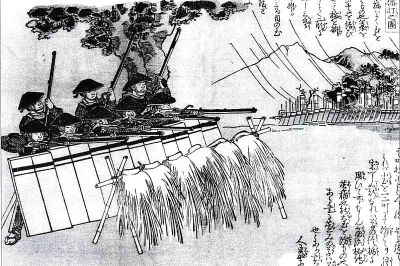
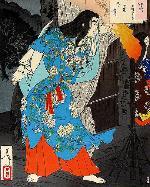
.jpg?timestamp=1582896954120)
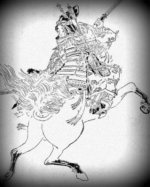
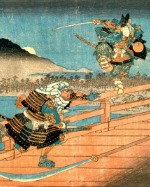
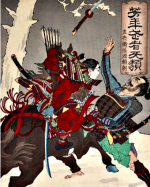
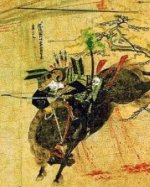
 thumb.jpg?timestamp=1582897488499)
